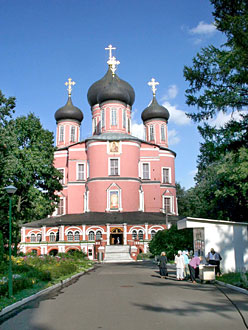 |
 Founded in 1591 to commemorate Boris Godunov's repulsion of a Tartar invasion under Khan Kazy-Girey, the Donskoy Monastery is one of the most impressively fortified in Moscow, and has had a turbulent and fascinating history.
Founded in 1591 to commemorate Boris Godunov's repulsion of a Tartar invasion under Khan Kazy-Girey, the Donskoy Monastery is one of the most impressively fortified in Moscow, and has had a turbulent and fascinating history.
Godunov roused his troops on the eve of battle by parading the icon Our Lady of the Don, which legend claimed had been carried by Dmitry Donskoy at the Battle of Kulikovo in 1380. When the Tartar forces fled after a brief skirmish, the decision was made to build a church to house the icon on the site and a monastery around it, which would also serve to protect the main highway from Moscow to the Crimea.
The original cathedral, now called the Old Cathedral or the Small Cathedral, was completed in 1593, and is a charming example of Moscow Baroque, painted soft red with typical kokoshniki - recessive rows of corbel arches that were a feature of Russian church architecture from the 12th Century - and topped with powder-blue onion domes. It now houses a copy of the icon, the original being on display in the Tretyakov Gallery.
The monastery was originally small and poor, and was abandoned altogether in the Time of Troubles after Godunov's death, and became an appendage of the Andronikov Monsatery. During the period it was again the scene of fighting, first when taken by the Polish for a day in 1612, and then when the streltsy defeated Ukranian Cossack forces beneath its walls in 1618. It was not until 1678, in the reign of Feodor III that the monastery regained its independence and began to prosper.
The Great or New Cathedral was begun in 1684 on the orders of Tsarina Sofia, Peter the Great's half-sister and regent for the early years of his reign. The cathedral has some unusual features which can be attributed to the fact that its builders were masons and artisans brought from Ukraine. According to Ukranian custom, the five domes of the cathedral are positioned to represent the four corners of the earth, a design which scandalized Old Believers, who gave it the name "The Antichrist's Altar". The impressive eight-tiered iconostasis was carved between 1688 and 1698, and centers on a sixteenth century copy of Lady of the Don. The frescoes in the cathedral were painted by Italian Antonio Claudio between 1782 and 1785, making them the first church paintings in Moscow to be executed by a foreigner.
At about the time of the construction of the New Cathedral, the walls of the monastery were also reconstructed in Moscow Baroque style. The high crenellated red walls, with twelve crowned towers built between 1686 and 1711, resemble those of the Novodevichy Convent. Of particular note is the soaring Gate-Church of the Tikhvin Virgin, which acts as the entrance to the monastery.
The plague that ravaged Moscow in 1771 not only brought riots to the monastery - during which Ambrosius, Archbishop of Moscow, who had fled from the Kremlin, was bludgeoned to death by an angry mob - it also led to an edict from Catherine the Great that no cemetery be located within the city limits. Seven Orthodox cemeteries were then established around the city, and the Donskoy Cemetery became the most prestigious. Among the great families that began to use the cemetery were the princes Golitsyn and Zubov, who built private chapels - the Alexander Svirsky Church and the Archangel Church respectively - within the grounds of the monastery.
The monastery was closed soon after the Revolution, and it was chosen by the Bolshevik government as the site for a Museum of Atheism, opened in the Great Cathedral in 1929. Patriarch Tikhon, who was invested in 1917, was held prisoner in the monastery from 1922 to 1923, and buried in an unmarked grave there. The monastery's hospital became the city's first crematorium, and a branch of the Shchusev Architectural Museum was established at the monastery to house (in semi-secret) sculptures and ornaments from destroyed churches. Services in the Old Cathedral resumed in 1946, but only in 1992 was the monastery returned to the Church. Soon after this event, which was marked by the reburial of Tikhon, a fire destroyed all the icons in the Great Cathedral. The monastery is still undergoing restoration work, but is an active institution with a publishing house and a studio for icon restoration.
|
 |

 Founded in 1591 to commemorate Boris Godunov's repulsion of a Tartar invasion under Khan Kazy-Girey, the Donskoy Monastery is one of the most impressively fortified in Moscow, and has had a turbulent and fascinating history.
Founded in 1591 to commemorate Boris Godunov's repulsion of a Tartar invasion under Khan Kazy-Girey, the Donskoy Monastery is one of the most impressively fortified in Moscow, and has had a turbulent and fascinating history.